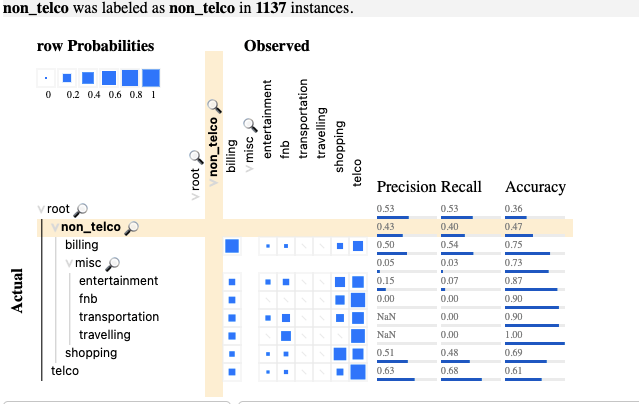The confusion matrix, a ubiquitous visualization for helping people evaluate machine learning models, is a tabular layout that compares predicted class labels against actual class labels over all data instances. Neo is a visual analytics system that enables practitioners to flexibly author and interact with hierarchical and multi-output confusion matrices, visualize derived metrics, renormalize confusions, and share matrix specifications.
This code accompanies the research paper:
Neo: Generalizing Confusion Matrix Visualization to Hierarchical and Multi-Output Labels
Jochen Görtler, Fred Hohman, Dominik Moritz, Kanit Wongsuphasawat, Donghao Ren, Rahul Nair, Marc Kirchner, Kayur Patel
ACM Conference on Human Factors in Computing Systems (CHI), 2022.
![]() Paper,
Paper, ![]() Live demo,
Live demo, ![]() Video,
Video, ![]() Video Preview,
Video Preview, ![]() Code
Code
You can embed our confusion matrix visualization into your own project. There are two ways to use it.
Install with npm install --save @apple/hierarchical-confusion-matrix or yarn add @apple/hierarchical-confusion-matrix.
Then you can import the module in your project
import confMat from '@apple/hierarchical-confusion-matrix';
const spec = {
classes: ['root'],
};
const confusions = [
{
actual: ['root:a'],
observed: ['root:a'],
count: 1,
},
{
actual: ['root:a'],
observed: ['root:b'],
count: 2,
},
{
actual: ['root:b'],
observed: ['root:a'],
count: 3,
},
{
actual: ['root:b'],
observed: ['root:b'],
count: 4,
},
];
confMat.embed('matContainer', spec, confusions);If you prefer to load the compiled JavaScript directly, you have to compile it. To do this, run yarn install and copy the public/confMat.js into your project. Here is a simple example of a small confusion matrix:
<!DOCTYPE html>
<html>
<head>
<meta charset="utf8" />
<meta name="viewport" content="width=device-width" />
<title>Neo: Hierarchical Confusion Matrix</title>
</head>
<body>
<div id="matContainer"></div>
<script src="confMat.js"></script>
<script>
const spec = {
classes: ['root'],
};
const confusions = [
{
actual: ['root:a'],
observed: ['root:a'],
count: 1,
},
{
actual: ['root:a'],
observed: ['root:b'],
count: 2,
},
{
actual: ['root:b'],
observed: ['root:a'],
count: 3,
},
{
actual: ['root:b'],
observed: ['root:b'],
count: 4,
},
];
confMat.embed('matContainer', spec, confusions);
</script>
</body>
</html>You can find all the options that you can pass via the spec argument in src/specification.ts.
The different loaders can be found in src/loaders, which include loading data from json, csv, vega, and a synthetic example synth for testing.
The confusions for data with actual labels of fruit:lemon that are incorrectly predicted as fruit:apple, of which there are count 1 of them.
{
"actual": ["fruit:lemon"],
"observed": ["fruit:apple"],
"count": 1
}The confusions for hierarchical data with actual labels of fruit:citrus:lemon that are incorrectly predicted as fruit:pome:apple, of which there are count 2 of them. Note : denotes hierarchies.
{
"actual": ["fruit:citrus:lemon"],
"observed": ["fruit:pome:apple"],
"count": 2
}The confusions for multi-output data with actual labels of fruit:lemon,taste:sweet that are incorrectly predicted as fruit:apple,taste:sour, of which there are count 3 of them. Note , denotes multi-ouput labels.
{
"actual": ["fruit:lemon", "taste:sweet"],
"observed": ["fruit:apple", "taste:sour"],
"count": 3
}The confusions for hierarchical and multi-output data with actual labels of fruit:citrus:lemon,taste:sweet,ripeness:ripe that are incorrectly predicted as fruit:pome:apple,taste:sour,ripeness:not-ripe, of which there are count 4 of them.
{
"actual": [
"fruit:citrus:lemon",
"taste:sweet",
"ripeness:ripe"
],
"observed": [
"fruit:pome:apple",
"taste:sour"
"ripeness:not-ripe"
],
"count": 4
}See fruit.json for a complete example of confusions for a hierarchical fruit, taste, and ripeness classification model.
Build:
yarn install
yarn buildTest:
yarn test:unitDev Server:
yarn devLint & Fix:
yarn lintWhen making contributions, refer to the CONTRIBUTING guidelines and read the CODE OF CONDUCT.
To cite our paper, please use:
@inproceedings{goertler2022neo,
title={Neo: Generalizing Confusion Matrix Visualization to Hierarchical and Multi-Output Labels},
author={Görtler, Jochen and Hohman, Fred and Moritz, Dominik and Wongsuphasawat, Kanit and Ren, Donghao and Nair, Rahul and Kirchner, Marc and Patel, Kayur},
booktitle={Proceedings of the SIGCHI Conference on Human Factors in Computing Systems},
year={2022},
organization={ACM},
doi={10.1145/3491102.3501823}
}This code is released under the LICENSE terms.





